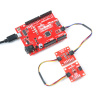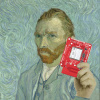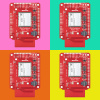Welcome back to the thought experiment journey I'm on to learn the best way to find a lost frisbee. Thanks so much to everybody who commented on the last post with ideas on which technologies you would use to approach this problem. I think that's why I like this challenge in the first place - there are half a dozen different technologies that could be used to find missing objects, but which one is the most effective for the scale of this particular use case of disc golf?
Disc golf course here in Boulder!
For those of you just catching up, SparkFun's photographer Juan and I are trying to figure out the best way to find a frisbee if it gets lost in the brush and swamps of a disc golf course. The immediate challenges in this are as follows:
- Proximity: You have to be close enough to the general area of the disc to see or hear anything attached to it, as well as scan any tags.
- Size: Whatever the solution is, it needs to have a very small and durable footprint that won't affect the disc's lift and stability. What good is tracking a frisbee if the device affects your throw? Plus, it might crash into a tree or into water, so it needs to be durable.
While my previous solution, trying to use a small GPS chip, could work, it isn't really ideal. Combined with power and a microcontroller, it's quite a bulky set-up, and it isn't always guaranteed that the chip will have a clear view of the sky, which would certainly skew the accuracy.
Which brings me to my next solution, one that a few of you suggested...using UHF RFID tags.
UHF RFID tags are ideal for this project in a lot of ways - for starters they are perhaps the smallest and most durable footprint. They can be waterproof, and can just be attached with an adhesive on the backside of the frisbee, and most don't need a battery, which means it's an even smaller footprint than the other options. The tag is just an antenna that receives RF waves, and an IC that processes the information.
Using a UHF RFID tag would remove the issue of building an attached enclosure
The other advantages of UHF RFID is that it doesn't require a line of sight like barcodes do, so the tag doesn't need to be showing for the scanner to pick up on it. Furthermore, multiple tags can be in the same area and still be differentiated, which makes this solution ideal for groups playing together.
Now, the major disadvantage of the using UHF RFID tags is that you need a mobile UHF scanner, which can be quite expensive for the scope of this project. So, it really comes down to what needs to be sacrificed in the project - what do you all think? UHF RFID Tags solve the majority of problems, but at a high cost. Is this the most effective way to find a lost frisbee, or could it another solution, like adding light and sound to the disc, or attaching an Airtag? Next time, I we'll explore both of those ideas. And keep on posting different ideas in the comments! I really liked that video system that records flight path; it would be heaps of fun to try to implement that project!










I fly FPV drone and we have buzzer on them that we can trigger with remote. There is also a way to program the motor speed controller where after X amount of inactivity the ESC start making the brushless motor beep. Yes brushless motor can be use as sound device. They do startup sound and some 32bit ESC can even play music. Anyway, I program mine to be activated with remote and also start beeping after 2min of not spinning. I would do something similar with the frisbee. I would use the shell of the frisbee to be the speaker chamber, exactly how the airtag is using the case as to amplify sound waves. Airtags are great but in tall grass, range is short. btw, I totally want to see that 350$ UHF scanner in use!
How many frisbee can you buy for 350$?
The comment about cost really comes down to how many items you plan to track and total cost of ownership.
The reader you linked to in this article is rather inexpensive (most I've seen are around $1400-1600 USD) and even that I'd consider to be fairly competitively priced.
If you look at alternative tracking technologies (UWB / BLE) the price per tag is significantly higher than $0.25-0.50 per tag, so if you plan on tracking more than 10-15 items, then what you've presented here is in fact the lower total cost solution
for example: $99 (for 4 tags) AirTag bundle is right around $25 per tag so 15 items @ $25 per item is right around $375, vs $0.4 x 15 + $350 for the scanner which would put you at $356 for the RFID solution
This isn't taking into consideration passive RFID tags (as you mentioned) also don't use batteries, so there's also no need to replace batteries down the road so no residual maintenance cost (though they may fall off so you might have to replace them if what they're stuck to doesn't stay stuck).
On the down side localization of RFID isn't great, going purely on RSSI which is prone to interference and reflection but is better than nothing. UWB tends to outshine RFID or BLE in localization / RTLS but as has been mentioned is far more expensive per tag.
Great article!